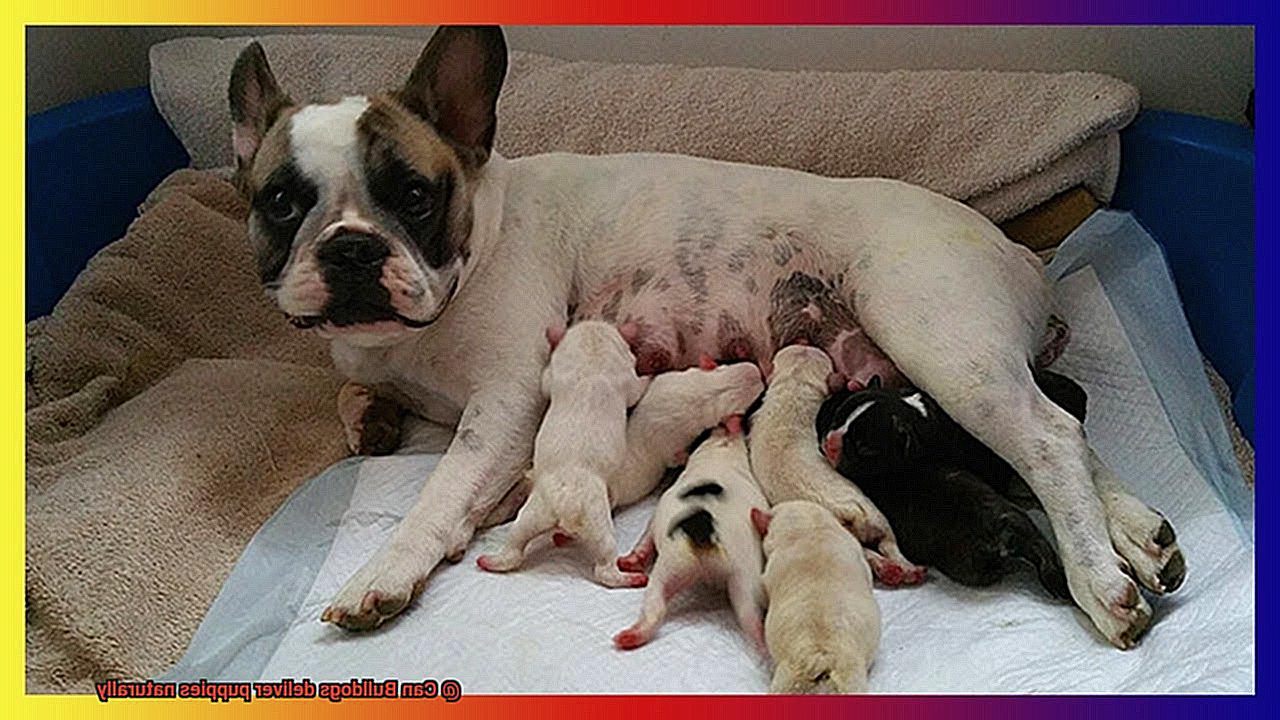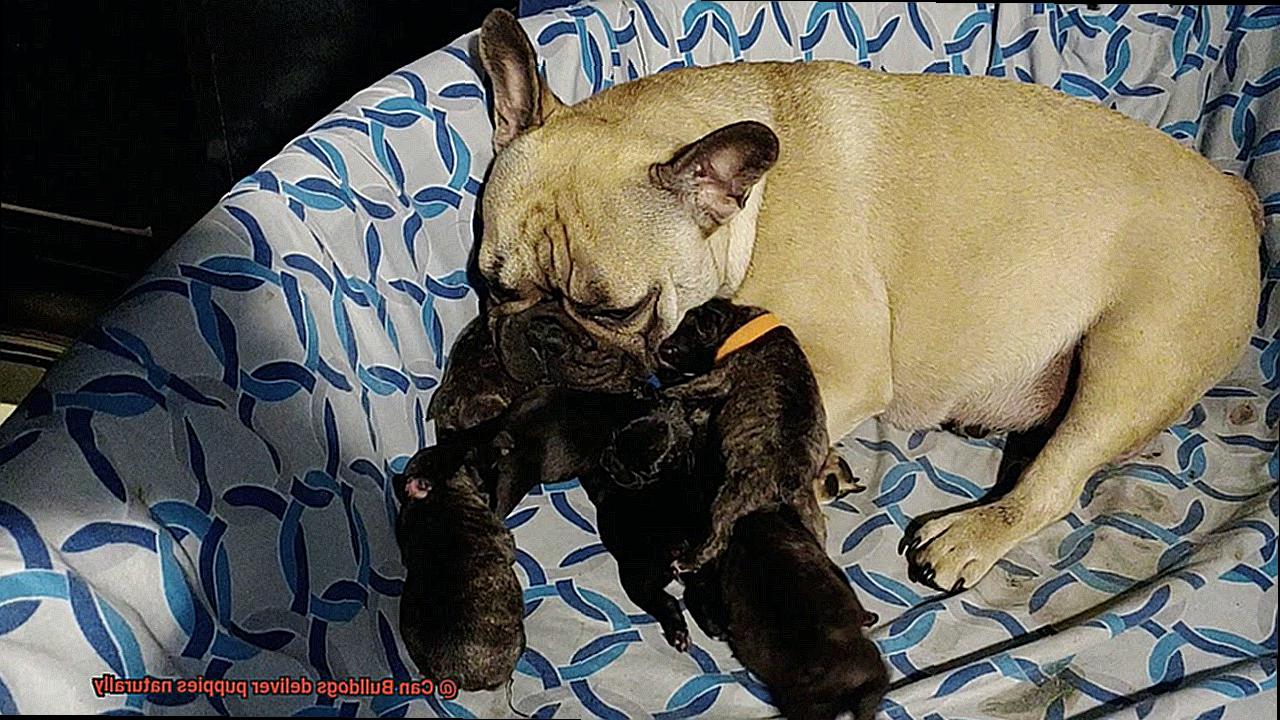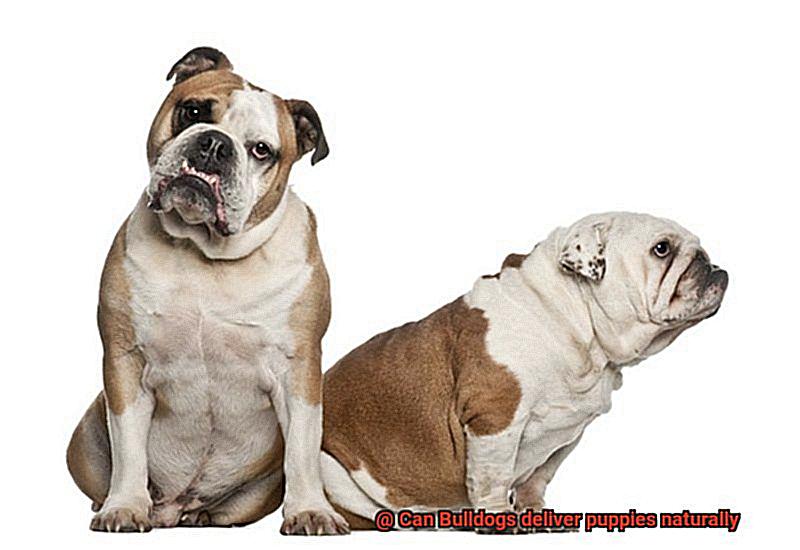Can Bulldogs deliver puppies naturally?
Today, we’re diving headfirst into the captivating question of whether Bulldogs can deliver puppies naturally.
We all know these squishy-faced cuties have left an indelible paw print on the world of canines, but their unique physique presents some hurdles when it comes to giving birth.
So, let’s get ready to unravel this intriguing and slightly controversial topic together. Get ready for a wild ride as we explore the natural birthing quandary that Bulldogs face.
The Anatomical Challenges of Bulldogs During Birthing
Contents
- 1 The Anatomical Challenges of Bulldogs During Birthing
- 2 Factors that Influence Natural Delivery in Bulldogs
- 3 The Role of Veterinary Assistance in Bulldog Breeding and Birthing
- 4 Benefits of Regular Prenatal Check-Ups for Bulldog Owners
- 5 Potential Complications During Bulldog Labor
- 6 How to Monitor the Birthing Process for Bulldogs
- 7 Possible Interventions for Assisting with Bulldog Births
- 8 Conclusion
Bulldogs, including French Bulldogs, are beloved for their adorable squished faces and compact bodies. However, these unique physical features can pose challenges during the birthing process. In this article, we will explore the anatomical challenges that Bulldogs face when giving birth and how owners can navigate these difficulties to ensure a safe delivery for their furry friends.

Brachycephalic Skull Structure
One of the main challenges Bulldogs encounter during birthing is their brachycephalic skull structure. Their short snouts and wide heads can make it difficult for them to give birth naturally. The narrow birth canals in Bulldogs may not be wide enough for puppies to pass through easily. Additionally, the puppies themselves often have larger heads compared to other breeds, further complicating the delivery process.
Uterine Inertia
Bulldogs are prone to a condition called “uterine inertia,” where the muscles of the uterus are weak and unable to contract effectively during labor. This can result in prolonged labor or even a stalled delivery. Veterinary intervention is often required in such cases to ensure the safe delivery of the puppies.
Excess Skin Folds and Wrinkles
Another potential problem Bulldogs face during birthing is the presence of excess skin folds and wrinkles around the vulva. These folds can obstruct the passage of puppies during birth, leading to complications and the need for veterinary assistance.
Size and Weight
The size and weight of Bulldogs can also contribute to birthing difficulties. Bulldogs are generally heavier than other breeds, which puts additional strain on their bodies during labor.
Seeking Veterinary Assistance
Due to these anatomical challenges, many Bulldogs require veterinary intervention or assistance during delivery.
This may involve cesarean sections or the use of medical techniques to aid in the birthing process. It is crucial for owners to consult with a veterinarian experienced in Bulldog birthing before the due date.
This way, they can be prepared for any potential complications and ensure the safety of both the mother and her puppies.
Factors that Influence Natural Delivery in Bulldogs
Well, you’ve come to the right place. In this blog post, we’ll dive into the nitty-gritty details of what goes on during a bulldog’s labor and delivery. So, grab a cup of coffee and get ready to learn.
- Breed Characteristics: Let’s start with the basics. Bulldogs, including our adorable Frenchies, have a unique body structure that can make natural delivery a bit challenging. Their big heads and broad shoulders can pose difficulties when trying to pass through the birth canal. Plus, their short, stocky bodies and narrow pelvis can add to the struggle.
- Size of the Dam: Size matters. The size of the female bulldog plays a crucial role in determining whether she can deliver naturally. Smaller dams may find it harder to accommodate those cute little puppies, which might result in needing a cesarean section (C-section) delivery.
- Puppy Size and Position: Just like in life, size and position matter during childbirth too. If the puppies are too big or positioned incorrectly within the dam’s uterus, it can hinder their journey through the birth canal. In such cases, a C-section might be needed to ensure a safe delivery.
- Age and Health of the Dam: Age is just a number, but it can affect labor and delivery for our bulldog moms. Older dogs or those with underlying health conditions may experience reduced strength and stamina during labor, making natural delivery more challenging.
- Breeding Practices: Responsible breeders are like superheroes. They prioritize their dogs’ health and well-being by carefully selecting breeding pairs based on their likelihood of producing offspring that can be delivered naturally. So, make sure you choose a breeder who knows their stuff.
- Pre-natal Care: Just like human moms, our furry moms also need some TLC during their pregnancies. Regular vet check-ups, proper nutrition, and appropriate exercise can help maintain the dam’s overall health and increase her chances of delivering naturally.
- Breeding History: Experience counts, even in the doggy world. A dam’s previous breeding history can give us insights into her ability to deliver naturally. If she has a track record of successful natural deliveries without complications, it bodes well for future pregnancies.
- Professional Assistance: It’s always good to have an expert by your side. Having an experienced veterinarian or breeder present during labor can greatly increase the chances of a successful natural delivery. They can guide you through the process, monitor progress, and step in if needed to ensure the safety of both mom and pups.
The Role of Veterinary Assistance in Bulldog Breeding and Birthing
If you’re preparing for the exciting journey of breeding and birthing your beloved French Bulldogs, it’s crucial to understand the importance of veterinary assistance. Bulldogs, including French Bulldogs, have unique anatomy and health needs that require professional guidance during the breeding and birthing process.
In this blog post, we will explore why veterinary assistance is essential for ensuring a safe and healthy experience for both mother and puppies.
Bulldogs’ Unique Anatomy:

French Bulldogs are brachycephalic breeds with flat faces and shortened airways, making breathing more challenging, especially during labor. Veterinary assistance is crucial in managing potential breathing difficulties.
Challenges in Natural Delivery:
The narrow birth canal of bulldogs can make natural delivery challenging. Puppies may struggle to pass through, increasing the risk of complications. Veterinary assistance helps navigate these challenges and ensures a successful delivery.
Optimal Timing for Breeding:

Veterinarians play a vital role in determining the optimal timing for breeding to maximize the chances of pregnancy and successful delivery. They perform tests and evaluations to ensure the health of both male and female bulldogs, including checking for genetic conditions that could be passed on to the offspring.
Artificial Insemination:
Due to the difficulty of natural mating, bulldogs often require artificial insemination. Veterinarians perform this procedure to ensure successful fertilization, increasing the chances of pregnancy.
Pregnancy Monitoring:
Throughout the pregnancy, regular veterinary check-ups are essential to monitor the health of the mother and developing puppies. Ultrasound examinations assess fetal well-being and detect any potential issues early on.
Caesarean Section:
Bulldogs have a high risk of complications during natural delivery, making a caesarean section a common recommendation by veterinarians. This surgical intervention ensures a safer birthing process for both the mother and the puppies. Veterinarians carefully deliver each puppy while monitoring their health and providing immediate medical attention if needed.
Postnatal Care:
After delivery, veterinarians continue to play a crucial role in postnatal care. They monitor the mother’s recovery and ensure proper nutrition for her and the puppies. Regular check-ups, vaccinations, and preventive care throughout a bulldog’s life are essential for maintaining their health and well-being.
Benefits of Regular Prenatal Check-Ups for Bulldog Owners
If you’re thinking about breeding your bulldog or have already embarked on this exciting journey, it’s crucial to prioritize the health and well-being of your furry friend and her adorable puppies.
One of the best ways to ensure a smooth and safe pregnancy is through regular prenatal check-ups. Trust me, these check-ups are like the superhero sidekick you never knew you needed. So, let’s dig into the benefits of these check-ups and why they’re a game-changer for bulldog owners.
Early Detection of Potential Issues:
Just like us humans, bulldogs can experience pregnancy complications. Regular prenatal check-ups allow your experienced veterinarian to detect and address any potential problems early on.
From dystocia (a fancy word for difficulty in labor) to gestational diabetes and eclampsia (low blood calcium levels), your vet will keep a keen eye out for any red flags and intervene as needed. This proactive approach ensures a safer, healthier pregnancy for both momma bulldog and her precious pups.
Routine Tests for Peace of Mind:
You know that saying, “knowledge is power”? Well, it couldn’t be truer when it comes to prenatal check-ups. During these appointments, your vet will perform routine tests like ultrasounds, blood work, and urine analysis.
These tests help assess the overall health of the mom-to-be and monitor the progress of her pregnancy. Plus, they can catch any underlying health conditions or abnormalities that may affect the pregnancy or delivery process. Talk about peace of mind.
Expert Guidance and Support:
Picture this: you’re sitting in the vet’s office, full of questions and concerns about your bulldog’s pregnancy journey. Well, fret no more. Regular prenatal check-ups give you the perfect opportunity to discuss all your worries with your trusted veterinarian. They’ll provide expert guidance, answer your questions, and offer the support you need throughout the pregnancy. It’s like having a personal bulldog baby guru.
Monitoring Puppies’ Growth and Development:
We all want those little bundles of joy to grow up healthy and strong, right? Regular prenatal check-ups ensure just that. Your vet will keep a close eye on the size and development of the puppies, making sure they’re growing as they should be. This way, any signs of distress or deformities can be detected early on, ensuring the best possible outcome for those adorable little bulldog babies.
Safe Delivery, Guaranteed:
Sometimes, nature needs a helping hand. Regular prenatal check-ups allow your vet to assess whether a natural delivery is possible and safe for both momma and her pups. If any concerns arise, they can make arrangements for a planned cesarean section to ensure a safe delivery. The well-being of your bulldog family is in good hands.
Potential Complications During Bulldog Labor
Today, we’re going to dive into the world of bulldog labor and discuss potential complications that can arise during this exciting time. As an expert in bulldog health, I’ve seen it all, from the joys of a smooth delivery to the challenges of dystocia. So, grab your café au lait and let’s get started.
Dystocia: A Bulldog’s Nemesis
First on our list is dystocia, the villain that often plagues our beloved bulldogs during labor. With their narrow pelvis and large heads, bulldogs face a tough battle when it comes to delivering those adorable puppies. Dystocia may require veterinary intervention, like a cesarean section, to ensure a safe delivery for both mom and pups.
Uterine Inertia: When the Uterus Takes a Breather
Uterine inertia can be another sneaky foe during bulldog labor. This occurs when the uterus fails to contract effectively, causing delays or even a complete halt in contractions. To kickstart the process, oxytocin administration or manual stimulation may be necessary – consider it a gentle nudge for Mother Nature.
Big Puppies: Bulldogs’ Little Challenge
Bulldogs are known for their big hearts, but they can also have big puppies. This can lead to complications, as these chunky pups may struggle to navigate their way through the narrow birth canal. Dystocia or a cesarean section may come to the rescue once again, ensuring a safe arrival for those precious little ones.
The Placenta Predicament
After each puppy is born, bulldogs sometimes face difficulty delivering the placenta. Retained placentas can spell trouble for mom, causing infection and other health issues. Keep a close eye on the delivery process and don’t hesitate to seek veterinary assistance if any placental complications arise.
Exhaustion and Heat, Bulldog Kryptonite
Our bulldog superheroes can easily become exhausted during labor due to their brachycephalic anatomy. Their shortened airways make it more challenging for them to breathe while exerting themselves. So, make sure they take breaks and don’t overexert themselves – even superheroes need rest.
Heat Regulation: Keeping Cool Under Pressure
Speaking of overheating, bulldogs are sensitive to heat, and labor can be an energy-draining affair. Keep the birthing environment cool and comfortable for mom, ensuring she doesn’t turn into a hot mess during this important time.
How to Monitor the Birthing Process for Bulldogs
Bringing new life into the world is an incredible experience, but it can also be challenging, especially for bulldogs like the adorable French Bulldogs. As a proud French Bulldog owner, it’s essential to monitor the birthing process closely to ensure the safety and well-being of your beloved pet and her precious puppies. In this article, we will explore the key aspects of monitoring the birthing process for Bulldogs, providing insights based on personal experiences and expert advice.
Observing Behavior and Physical Signs:
As your French Bulldog’s due date approaches, keep a watchful eye on her behavior and physical signs. Restlessness, nesting behaviors, and a decreased appetite are common indicators that labor is imminent. These signs serve as nature’s way of preparing for the arrival of the puppies.
Monitoring Contractions:
During labor, pay close attention to your French Bulldog’s contractions. You’ll notice her abdomen tightening and relaxing rhythmically. Timing these contractions can help determine if they are progressing normally or if there are any abnormalities.
Temperature Drop:
Regularly check your French Bulldog’s temperature before labor begins. A drop in temperature below 100°F (37.8°C) indicates that labor will start within 24 hours. This is a reliable indicator to anticipate the birth.
Assessing Pushing Ability:
Observe your French Bulldog’s ability to push during contractions. If she is unable to deliver a puppy after continuous pushing for more than 30 minutes, it may indicate a problem, and immediate veterinary assistance should be sought.
Amniotic Sac and Puppies’ Progress:
Keep an eye on the amniotic sacs surrounding each puppy. Your French Bulldog should instinctively break these sacs and clean up her puppies. However, if she fails to do so, gently remove the sacs to ensure proper breathing for each puppy. Additionally, monitor the puppies’ progress during birth. Puppies should be born within 10-60 minutes of each other. If there is a prolonged delay or a puppy appears stuck, seek veterinary intervention.
Possible Interventions for Assisting with Bulldog Births
French Bulldogs are adorable and beloved pets, but their unique anatomy can sometimes present challenges during the birthing process. As a responsible owner, it’s essential to be prepared and familiarize yourself with possible interventions that can assist with bulldog births. Let’s dive into some of the interventions that can help ensure a safe and successful delivery for your furry friend.
- Oxytocin: This hormone can be administered by a veterinarian to stimulate uterine contractions and speed up labor. It’s particularly useful if your bulldog is experiencing weak or prolonged contractions.
- Manual Assistance: Sometimes, a gentle hand is needed to guide the puppies out of the birth canal. A trained veterinarian or breeder may need to assist by gently pulling on the puppy or repositioning it if it becomes stuck.
- Caesarean Section: In more complicated cases, a C-section may be necessary. This surgical procedure involves making an incision in the mother’s abdomen to safely deliver the puppies. It’s usually recommended when there are complications like dystocia or if the mother is unable to give birth naturally.
Remember, these interventions should always be carried out by a trained professional. Attempting to assist with a bulldog birth without proper knowledge and experience can put both the mother and puppies at risk.
To ensure a smooth birthing process, it’s crucial to work closely with your veterinarian throughout your bulldog’s pregnancy. Regular check-ups and ultrasounds can help identify any potential issues early on so that appropriate interventions can be planned.
Creating a calm and stress-free environment during labor is also essential. Keep noise levels low, minimize distractions, and provide comfort for the mother to reduce anxiety and promote a smoother delivery.
After the birth, closely monitor both the mother and puppies for any signs of complications or distress. If you notice anything concerning, contact your veterinarian immediately.
yjAL0GYHDv8″ >
Conclusion
In conclusion, it is important to understand that Bulldogs, due to their unique physical characteristics, often struggle with delivering puppies naturally. The breed’s large heads and narrow hips make it difficult for them to give birth without assistance. This is why it is crucial for Bulldog owners to be prepared and vigilant during the birthing process.
It is recommended that Bulldogs undergo a cesarean section (C-section) in order to ensure the safety of both the mother and her puppies. This surgical procedure allows for a controlled delivery, reducing the risk of complications or injury.
While some Bulldogs may be able to deliver puppies naturally under certain circumstances, such as having a smaller litter size or receiving expert veterinary care, it is generally advised to opt for a C-section. This approach minimizes potential risks and ensures a smooth and successful delivery.
In conclusion, although Bulldogs have difficulty delivering puppies naturally, modern veterinary medicine has provided safe alternatives such as C-sections.




